Difference between revisions of "Verification of Relativistic Components"
(→Setup) |
|||
| (12 intermediate revisions by the same user not shown) | |||
| Line 7: | Line 7: | ||
Then using the kinematics equations displayed above, used to reverse calculate the scattered electron's momentum and angles. The root histograms of an incoming 11GeV electron (in blue) are overlaid with the relativistic calculations starting with the Moller electron (Reverse Moller in red) and show good agreement. | Then using the kinematics equations displayed above, used to reverse calculate the scattered electron's momentum and angles. The root histograms of an incoming 11GeV electron (in blue) are overlaid with the relativistic calculations starting with the Moller electron (Reverse Moller in red) and show good agreement. | ||
| − | + | ||
| + | =Final Momentum in the Lab Frame= | ||
<center>[[File:FnlMom_backwards.png]][[File:MolMom_reverse.png]]</center> | <center>[[File:FnlMom_backwards.png]][[File:MolMom_reverse.png]]</center> | ||
| Line 14: | Line 15: | ||
<center>[[File:FnlTheta_reverse.png]][[File:MolTheta_reverse.png]]</center> | <center>[[File:FnlTheta_reverse.png]][[File:MolTheta_reverse.png]]</center> | ||
| + | =Theta in the CM Frame= | ||
| + | <center>[[File:FnlThetaCM_reverse.png]][[File:MolThetaCM_reverse.png]]</center> | ||
=Momentum in the CM Frame= | =Momentum in the CM Frame= | ||
| Line 19: | Line 22: | ||
The differences in these plots come from fact that the "Forward" plots come from a GEANT simulation in which a small amount of energy was lost traveling through the target material. | The differences in these plots come from fact that the "Forward" plots come from a GEANT simulation in which a small amount of energy was lost traveling through the target material. | ||
| + | {| border="1" | ||
| + | |- | ||
| + | ! KE<sub>i</sub> | ||
| + | ! Px<sub>i</sub> | ||
| + | ! Py<sub>i</sub> | ||
| + | ! Pz<sub>i</sub> | ||
| + | ! x<sub>i</sub> | ||
| + | ! y<sub>i</sub> | ||
| + | ! z<sub>1</sub> | ||
| + | ! KE<sub>f</sub> | ||
| + | ! Px<sub>f</sub> | ||
| + | ! Py<sub>f</sub> | ||
| + | ! Pz<sub>f</sub> | ||
| + | ! x<sub>f</sub> | ||
| + | ! y<sub>f</sub> | ||
| + | ! z<sub>f</sub> | ||
| + | ! KE<sub>m</sub> | ||
| + | ! Px<sub>m</sub> | ||
| + | ! Py<sub>m</sub> | ||
| + | ! Pz<sub>m</sub> | ||
| + | ! x<sub>m</sub> | ||
| + | ! y<sub>m</sub> | ||
| + | ! z<sub>m</sub> | ||
| + | |- | ||
| + | | 11000 | ||
| + | | 0 | ||
| + | | 0 | ||
| + | | 11000.5 | ||
| + | | 0 | ||
| + | | 0 | ||
| + | | -510 | ||
| + | | 10931.3 | ||
| + | | -7.51848 | ||
| + | | -3.62463 | ||
| + | | 10931.8 | ||
| + | | 0 | ||
| + | | 0 | ||
| + | | -509.361 | ||
| + | | 68.5938 | ||
| + | | 7.51848 | ||
| + | | 3.62463 | ||
| + | | 68.597 | ||
| + | | 0 | ||
| + | | 0 | ||
| + | | -509.361 | ||
| + | |} | ||
| + | |||
| + | The particles start out with p=11000.511 MeV and have on average ~11000 MeV by the time they interact | ||
| + | |||
| + | <center>[[File:Screen_Shot_2016-02-01_at_9.30.23_PM.png]]</center> | ||
| + | |||
| + | <center>[[File:Screen_Shot_2016-02-01_at_9.29.40_PM.png]]</center> | ||
| − | = | + | |
| − | + | =Conclusion= | |
| + | |||
| + | The energy loss must be dealt with by using both momentum components from a GEANT Moller Scattering data file. By using both components, they can be transformed to a CM Frame, then have the phi angle varied to cover 2π radians. A quick awk search shows that there are no Moller electrons with energy over 5500 MeV. This might be able to be fixed by switching the scattered electron with the Moller electron, allowing a larger range of energy to be covered. | ||
Latest revision as of 15:56, 4 February 2016
Setup
Verifying that the kinematics are valid, the Moller momentum from GEANT simulations are extracted using
awk '{print $16, $17, $18}' MollerScattering_NH3_Large.dat > Just_Mol_Mom.dat
Then using the kinematics equations displayed above, used to reverse calculate the scattered electron's momentum and angles. The root histograms of an incoming 11GeV electron (in blue) are overlaid with the relativistic calculations starting with the Moller electron (Reverse Moller in red) and show good agreement.
Final Momentum in the Lab Frame
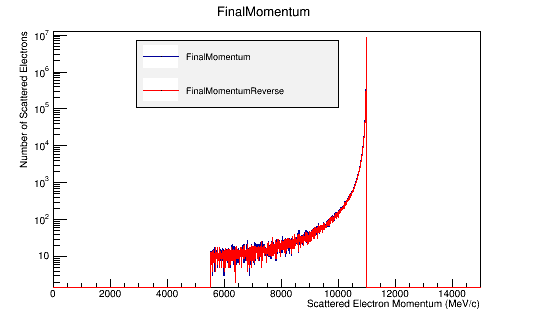
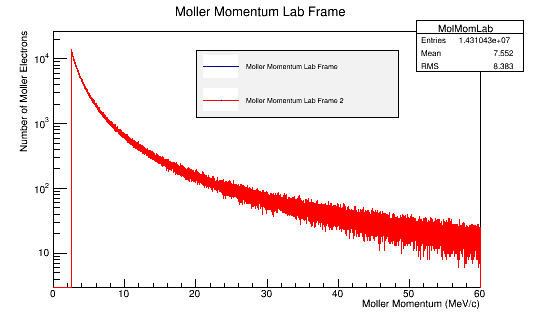
Final Thetas in the Lab Frame
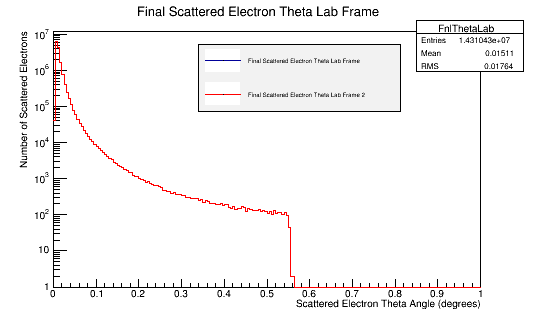
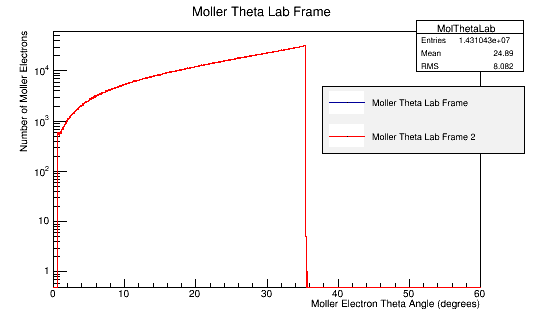
Theta in the CM Frame
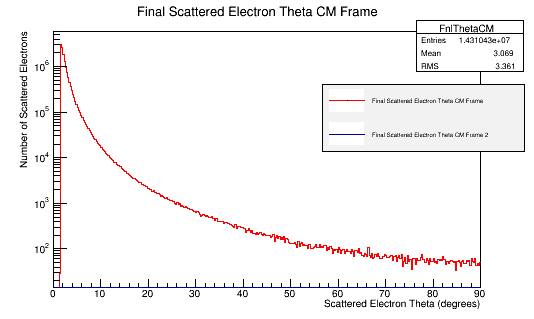
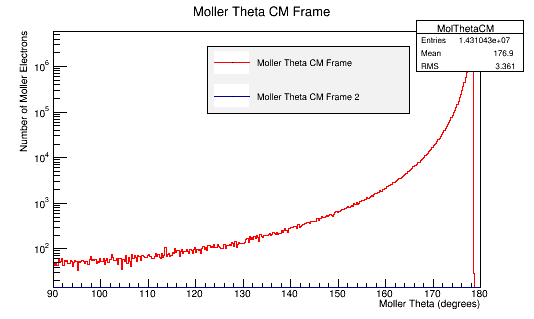
Momentum in the CM Frame
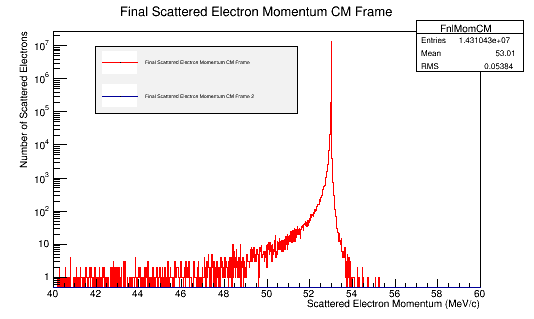
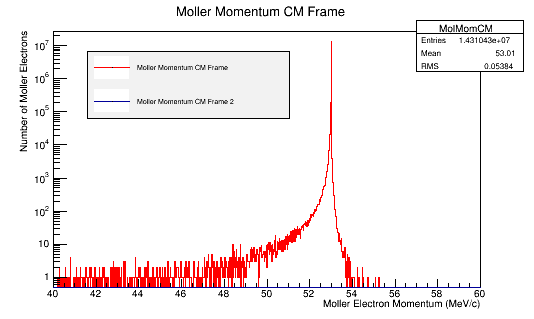
The differences in these plots come from fact that the "Forward" plots come from a GEANT simulation in which a small amount of energy was lost traveling through the target material.
| KEi | Pxi | Pyi | Pzi | xi | yi | z1 | KEf | Pxf | Pyf | Pzf | xf | yf | zf | KEm | Pxm | Pym | Pzm | xm | ym | zm |
|---|---|---|---|---|---|---|---|---|---|---|---|---|---|---|---|---|---|---|---|---|
| 11000 | 0 | 0 | 11000.5 | 0 | 0 | -510 | 10931.3 | -7.51848 | -3.62463 | 10931.8 | 0 | 0 | -509.361 | 68.5938 | 7.51848 | 3.62463 | 68.597 | 0 | 0 | -509.361 |
The particles start out with p=11000.511 MeV and have on average ~11000 MeV by the time they interact


Conclusion
The energy loss must be dealt with by using both momentum components from a GEANT Moller Scattering data file. By using both components, they can be transformed to a CM Frame, then have the phi angle varied to cover 2π radians. A quick awk search shows that there are no Moller electrons with energy over 5500 MeV. This might be able to be fixed by switching the scattered electron with the Moller electron, allowing a larger range of energy to be covered.